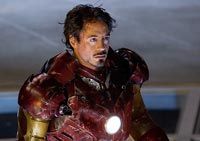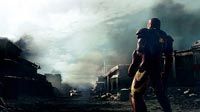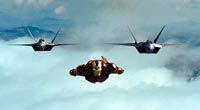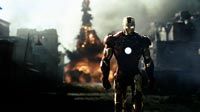When I was just a lowly movie geek/freak living in Minnesota, writing for the site in my spare time, there were a few places I had always wanted to check out. Within a year of moving to Los Angeles, I’ve gotten to visit two of the biggest ones on my list. One was Comic-Con and the other was the hallowed grounds of Industrial Light and Magic, known simply to us in movie geekdom as ILM. I experienced the maddening insanity of the Comic-Con convention floor in San Diego earlier this summer and, two weeks ago I was up in San Francisco at ILM’s new home at The Presidio for a press event to chat with some of the folks behind the visual effects magic of two of this summer’s biggest theatrical hits: Iron Man, which hits the shelves on DVD and Blu-Ray on September 30, and Indiana Jones and the Kingdom of the Crystal Skull, which will come to DVD and Blu-Ray on October 14. I’ll be splitting my day up into two parts and Iron Man is up first, but, before that, here’s a little history lesson on this famed company.
Industrial Light and Magic was founded in 1975 by now-legendary filmmaker George Lucas and since then, the company has worked on the visual effects for almost 200 films, starting with, of course, Star Wars: Episode IV - A New Hope all the way up to the two films being discussed today. Along the way the company has picked up 15 Oscars for Best Visual Effects along with 20 Scientific and Technical Achievement Awards and the company was one of the primary innovators of the blue-screen technology used in practically every film and also motion-capture technology and many more. All of this innovation is housed within a four-building, 850,000 square-foot compound at The Presidio in San Francisco, but enough about the past. Lets get into the present.
We started our day with a tour of this immense facility and this tour would turn the surliest of movie geeks into kids in a candy store. There were just so many damn cool things on display in these buildings I don’t even know where to start. For one, it is said that George Lucas has one of the largest private collections of movie posters in the world, and his sprawling collection can be seen in every hallway of ILM… and, yes, I do mean EVERY HALLWAY. Apparently, Lucas himself even hand-picked most of the actual locations of his precious collection and had a big hand in designing the décor of his buildings. The collection even goes into fan art as well.
The tour was chocked full of awesomeness, including a glimpse at one of the very first machines used to create visual effects and a stop at the ILM gift shop, which is only open to employees and “special guests” like us. When you get a chance to shop somewhere no one else can, even I had to buy something and a grey Skywalker Ranch t-shirt now hangs in my closet. However, we weren’t there to sightsee and even though I could’ve/would’ve walked around those buildings all day, we had people to see, and interviews to conduct.
We were lead into a large conference room and were met by three of the minds of ILM that brought Tony Stark’s creation to life. Ben Snow served as the Visual Effects Supervisor on Iron Man, Hal Hickel was the Animation Supervisor and Aaron McBride was on board as the Visual Effects Art Director on the film. McBride and Hickel both have an Oscar to show for their work at ILM and Snow has been nominated twice before as well. Aside from their work on this amazing film, they’ve worked on such modern classics as The Lost World: Jurassic Park, Minority Report as well as all three of the Pirates of the Caribbean films and the new Star Wars trilogy as well.
Aaron McBride talked to us next and he talked to us first about the design elements of the big suit-up sequence, and how they designed those incredibly elaborate robotic arms that turned Tony Stark into Iron Man. He showed us some early designs of his workshop and how they designed it so the whole device could be hidden so no one else could see. “In the sequence, we see him just saunter right in and let these things have their way with him.”
When asked about the designs of the Iron Monger and Iron Man suits, Snow jumped back in and said, “They were originally designed by a couple of people in the art department, and then Winston refined it to try and engineer how to get a guy into it, the suit, which was actually great that they did that.” He also talked about his experience actually being in the Iron Monger suit. “When we were shooting it, they had this scene, a second-unit shot, and the photo doubles were stuck in traffic on the 405 in L.A. and they needed a bald guy. Everyone else stepped back. I went through the whole Hollywood make-up scene and I tried to sneak back to the set but I went down this side corridor and Jon Favreau was there and I said, ‘This is what I’ll do to save your digital double shot.’”
It was asked about the stuff that they shot twice, both for practical and CGI, because they didn’t know how much would be used for practical and how much for CGI, and at what point they realized it would be mostly CGI. Snow replied, “You know, when they first approached us about the film, they really felt, at that point, that they would really go ahead with the CGI route. Then the realities of budget set in. They both realized that if they could get shots practically, that would be great to do it. We were also saying, ‘If you have a practical suit there, that’s only going to help us.’ We went into it with the idea that we would try to achieve as much as we could practically. We at ILM worked with Winston’s, but a couple of things happened. One was, because the suit is so heavy, and it’s tight, it just was constraining in how the performers were able to move in it. It was also uncomfortable to wear, so we got in a situation where we started pulling pieces of the suit off, more and more and more where at the end, people were wearing, essentially, some of the motion capture things. So, the actor wasn’t really wearing much. It was really, as the production evolved, the reality that, yes, it would end up being mostly CG, sunk in, but I think we all wanted to push for it to be as real as possible.”
Hal Hickel talked to us lastly and he dealt with the animation process of the suits and solving some problems that the actual Winston suits presented, some of which may be surprising. “The armpits was a big design issue. The suits weren’t able to allow this motion (they showed us a shot of raising the arm up from the side), in terms of these plates, so that was kind of a big cheat for us. We had to figure out what happens under there and some of that we actually made work, and some of it is a cheat, it’s a little bit of both.”
Hickel also talked about the Three F’s of Iron Man, which are “Flying, fighting and looking f-ing cool,” which brought a laugh to the journalists assembled. In the Flying aspect, he talked about an interesting anecdote that director Jon Favreau said that was, “really crucial about Iron Man. He said, ‘Superman takes off fast and lands slow, if you think about it. He takes off really fast and always comes down for those soft landings. Iron Man is the opposite. He takes off slow and lands fast,” which makes perfect sense. “Flight almost has its own character arc in the film. It had to start out as pretty out of control and he’s just barely holding it together. Then later in the film, it’s much more controlled and he knows what he’s doing and finally, he’s doing much more aerobatic kind of maneuvers and he has much more of a handle on it.”
As far as the fighting, particularly the Iron Man/Iron Monger fight, Hickel talked about how they were key-frame animated instead of motion-captured. “Right off the bat we knew that Iron Man was going to be fighting Monger and, because of the scale difference, we thought, ‘Well maybe they would be motion captured,’ but how would that work with two guys of the same stature wrestling and you apply the motion to these guys and it’s not going to work. We thought a lot about it, but I really thought it would be better to have him key-frame animated because, the great thing you get with motion-capture is you get all the noise and detail that real people have in their movements and its hard for animators to get all that detail in there, but I didn’t think it looked good with that noise and movement. I wanted to pare it down to something that was more powerful and direct. When we knew that he would be hand-animated, it simplified it.”
Iron Man ILMHe also added a really funny story as well about the suit-up sequence, and how they had to digitally fix the stand-in’s hair, because Robert Downey Jr. wasn’t available at that time. “Since this sequence was added late, Robert wasn’t available for that last shot so they had a stand-in, but the stand-in’s hair was too long so we ended up having to replace his hair and do a bunch of stuff to his head. I told Jon, I said, ‘Why don’t we just have two little arms that come down with a pair of scissors and a comb. Over the course of it, they’re cutting and trimming and one of them has a little whisk brush that comes in. He paused. He paused just for a second.”
After we wrapped up that very informative and entertaining hour-long presentation, our last stop of the day was with Michael Sanders, who did a lot of the MoCap and iMoCap work on the film and he had a special treat for us. He had a camera set up and he enabled each of us to actually be Iron Man, if only for a brief amount of time. We all got to sit in a chair and say a very brief message as Iron Man. It was the very end part of the suit-up scene where they close in on Downey Jr.’s face as the face lid closes. I was wrangled in to be the first volunteer here and, given the short notice, I couldn’t think of much to say, but here’s what I came up with.
Pretty bad, eh? Best I could do on short notice. It's pretty damn amazing that there is technology out there that any old Internet journalist could be a superhero, even for just a few seconds. Anyway, that about wraps up the Iron Man part of my wonderous day at ILM. Stay tuned for the second part of my visit where we talk to some of the digital wizards behind Indiana Jones and the Kingdom of the Crystal Skull. This was one hell of a day, folks, and I can’t wait to go back to this amazing facility! Peace in. Gallagher out!




